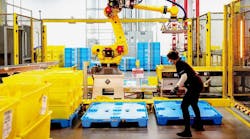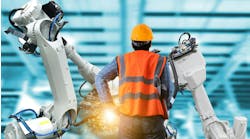The manufacturing industry has long been a cornerstone of global economic development, providing jobs and products that form the backbone of various sectors. However, the industry has faced unprecedented challenges in recent years, resulting in widespread disruptions, particularly on the staffing and recruitment front.
These disruptions—namely a 39% turnover rate in 2022—have exposed vulnerabilities in manufacturing’s workforce and emphasized the urgent need to address these challenges, both in the short term and in the years to come. According to the National Association of Manufacturers, 2.1 million U.S. manufacturing jobs could go unfilled by 2030, so opportunity certainly is there for automation to help fill in gaps in available labor in industry.
See also: AI and automation power self-managed warehouses
Future-proofing, or anticipating future developments and minimizing disruptions, is a delicate balance of several factors for a manufacturing business. While not the sole solution, adopting automation and phasing it in properly within your organization can go a long way toward easing some of the burdens associated with workforce shortages and help set your facility on solid footing for the future.
Done properly, automation also can play a crucial role in freeing up humans to handle different tasks. When you liberate your employees from routine, manual, or repetitive activities, you allow them to focus on more complex, strategic, and value-added tasks.
Understanding the benefits for your business
Automation in manufacturing settings has the potential to alleviate several pain points associated with staffing shortages, offering solutions to challenges that arise from workforce limitations. When implemented thoughtfully, these solutions reap several benefits for the industry.
First, automation can significantly enhance the efficiency and productivity of manufacturing processes. Automated systems can operate 24/7 without the need for breaks, reducing downtime and maximizing output. This increased efficiency helps compensate for reduced manpower during staffing shortages, ensuring that manufacturing targets are met despite workforce limitations. The ability to maintain operations around the clock also contributes to meeting market demands and deadlines, particularly with the rise in e-commerce.
See also: Video and audio: How the 'DIY' approach can help your industrial automation
This productivity is boosted more by new levels of operational flexibility. Automated systems are often designed to be flexible and adaptable, allowing quick changes to production processes based on demand fluctuations. This flexibility is crucial during staffing shortages when the workforce may not be sufficient to handle sudden changes in production requirements.
These technologies can also be easily reconfigured to accommodate varying workloads, providing a level of operational adaptability that traditional manual processes may lack.
Lastly, automation can help future-proof your business with better safety, precision, and quality.
Because automated systems consistently perform tasks accurately, you benefit from the reduced likelihood of errors associated with manual labor. As a result, manufacturers can maintain quality standards even with a reduced workforce, mitigating the risk of defects and the need for rework.
See also: Inside the Rockwell, Church & Dwight OT cybersecurity team-up
For workers that interact with the automated systems regularly, they benefit from a safer working environment. Automation can reduce the risk of injuries to human workers by handling dangerous tasks and minimizing the likelihood of accidents, which is especially important when your workforce is already stretched thin.
How and where to prioritize automation adoption
The potential benefits of automated processes in the manufacturing space are countless. However, to effectively implement automation, it’s crucial to take a targeted and comprehensive approach. Manufacturing operations are highly nuanced, and you might need a different approach depending on your vertical, but here are a few strategies to help guide your automation execution in a way that supports and bolsters your workforce.
Identify where to offload tasks: Ask what are your most repetitive and mundane tasks, like assembly, sorting, and packaging? When you automate these tasks and delegate them to machines—whether to automated storage and retrieval systems, automated guided vehicles, crane systems, etc.—you release your human resources from the burden of repetitive labor, allowing them to focus on tasks that require more creativity, problem-solving, and critical thinking.
Equip skilled workers with innovative technology: Once you’ve identified the tasks that are ripe for automation, it’s time to arm your skilled workers with up-to-date and innovative technology. This involves providing comprehensive training programs to ensure that employees are well-versed in operating and maintaining automated systems.
See also: Automation is the answer in 2024 for combating manufacturing challenges
Mitigate risks of injuries and damaged equipment: Automated solutions should prioritize the safety of the workforce and equipment. Automation, when implemented without adequate safety measures, can pose risks. Therefore, investing in technologies with built-in safety features and conducting regular safety audits is essential.
Standardized solutions for controls: In times of labor shortages, deploying standardized solutions for controls becomes crucial. These solutions should incorporate safeguard sensors that prevent accidental misuse, providing a fail-safe mechanism. Standardization also simplifies the learning curve for operators, allowing them to gain confidence quickly, increasing their throughput.
Continuous training and adaptation: Automation is not a one-time implementation; it requires continuous training and adaptation. Establishing a culture of lifelong learning is essential. This involves regularly updating employees on the latest advancements in automation, fostering a mindset of adaptability and agility.
Automation, for efficiency, productivity, and resilience
Businesses across all verticals are being asked to do more with less. This means a greater demand to keep up productivity and efficiency with tighter internal resources. Automation stands as a powerful tool to not only address the immediate issues of workforce shortages but also to fortify operations against future uncertainties.
See also: Industrial automation pulse check: What’s working, what needs work
By strategically implementing automation, businesses in the manufacturing space can enhance efficiency, productivity, and resilience, ensuring they remain agile in a rapidly evolving industrial landscape.



